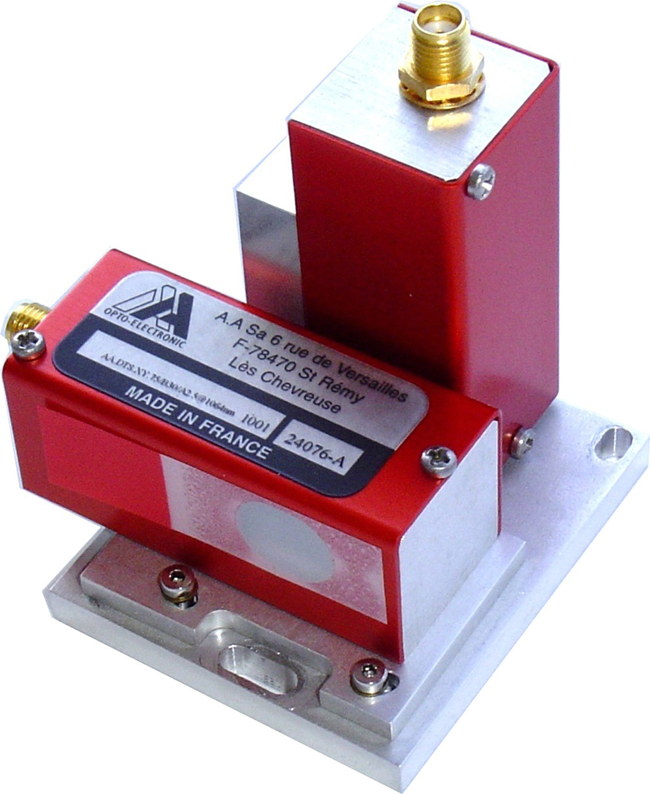Lydia Jim, Technical Sales Engineer at Photon Lines, discusses how acousto-optics are advancing the development of new laser-based techniques
Sat on the optical table, in the beam path between the titanium sapphire laser and the frequency doubler, is the acousto-optic modulator of our time-resolved photoluminescence spectroscopy lab. I shared this lab with my fellow university students, investigating indium gallium nitride / gallium nitride quantum wells. Access to the lab, with its complicated timing electronics and optical systems, was only granted once I had passed the 'test' - our research group’s equivalent of 'the knowledge' faced by London’s black cab drivers, which involved explaining the system to the (slightly intimidating) principal investigator.
The acousto-optic modulator was a key part of our time-resolved photoluminescence spectroscopy lab, which utilised the time-correlated single-photon counting technique. I had spent many dark hours in that lab, luckily, often with lab friends. The acousto-optic modulator was used as a pulse picker to periodically diffract the beam; it was triggered by an alternating current signal via a driver which also acted as the 'start' signal to the timing electronics. The selected light pulses from the pulse picker, after passing through various optics, was used to excite the quantum wells. The subsequent photons emitted by electrons’ de-excitation within the quantum wells was directed to a spectrometer and a photomultiplier tube, which converted the photons into an electrical 'stop' signal. This effectively measured the time taken from when a laser pulse was triggered by the acousto-optic modulator to when a signal triggered by photoluminescence from the sample was detected.
It is really, in my role as a technical sales engineer, that I have realised acousto-optic modulators are a common component in the labs of many researchers. Since joining Photon Lines in September 2019, I have had the opportunity to be in contact with groups who use acousto-optic modulators in cold atom research for laser cooling experiments, in stimulated emission depletion microscopy for power modulation and fast blanking, and as pulse pickers to excite single photon quantum emitters. They are purchased in OEM quantities by a leading laser manufacturer of next-generation automated ultrafast tunable lasers, which are designed to address the most demanding requirements in two-photon imaging and spectroscopy. The applications which require acousto-optic modulators are vast. Prior to working in Photon Lines, I also did not realise that they also acted as frequency shifters!
What are acousto-optical modulators?
Acousto-optic modulators are part of the larger family of acousto-optic devices, which all operate on the same principle. An acousto-optic device is made up of a radio frequency (RF) driver which is connected to a suitable crystal via a piezo-electric transducer. The piezo-electric transducer converts the radio frequency electric signal from the driver to acoustic (sound) waves in the crystal. The acoustic waves act as a 'phase grating', which travels through the crystal and can diffract incident laser beams. Most acousto-optic devices operate in the Bragg regime, where the beam is incident on the crystal at a particular angle, such that only the first order diffracted beam is produced alongside the transmitted beam.
There are two main types of acousto-optic devices which are commonly used in research: acousto-optic modulators, which also act as fixed frequency shifters and can be used for pulse picking, and acousto-optic deflectors, which also act as variable frequency shifters. Also commonly used, but often found as an integrated component to pulsed lasers rather than as a separate component, are Q-switches, mode lockers and cavity dumpers. These are special modulators designed for use in laser cavities and generally operate in the Raman-Nath regime, where the incident laser beam is normal to the acoustic wave.
Why use acousto-optic devices?
In acousto-optic devices, the intensity of the diffracted beam is dependent on the acoustic power. By varying the signal to the driver which supplies the RF signal to the piezoelectric transducer bonded to the crystal, the acoustic power, and hence the diffracted beam intensity, can be modulated. This principal nature of acousto-optic devices allows them to be used as pulse pickers, fast switches and in pulsed lasers, as Q-switches, cavity dumpers and mode lockers.
The other important property of acousto-optic devices is that the angle of diffraction of the output beam relative to the incident beam is a function of the acoustic frequency of the sound wave travelling through the crystal (and hence dependent on the driver frequency). Acousto-optic modulators are designed to be operated at one fixed RF frequency and acousto-optic deflectors are designed to be operated over a range of RF frequencies; this means that acousto-optic modulators can deflect a beam by a fixed angle and that acousto-optic deflectors can be used to deflect a beam over a range of angles, or to accurately control the angle of the output beam. Acousto-optic deflectors are well suited for applications where a laser beam is used to scan over a wide range of angles or where control of the direction of the beam is important - for example, in laser scanners, fluorescence microscopy and optical tweezers. An exciting relatively new technique called interferometric scattering mass spectrometry (iSCAMS), in which the AO deflector is a key component, is making it possible to measure molecular mass with an accuracy close to that of state-of-the-art mass spectrometry, but at much lower cost.

Acousto Optic X-Y Deflector
As mentioned previously, acousto-optic devices also act as frequency shifters. The frequency of the incident beam is shifted via the Doppler effect. Since the shift of the diffracted beam is simply given by the frequency of the acoustic wave due to energy conservation, acousto-optic modulators and deflectors also behave as fixed and variable frequency shifters, respectively. This property is of particular interest for heterodyning applications and laser cooling. It is also worth mentioning that acousto-optics can be used as tuneable filters since the angle of deflection of the diffracted beam is dependent on the optical wavelength of the input beam.
The ability of acousto-optic devices to modulate, deflect and shift the frequency of light means that the use of acousto-optic devices goes hand-in-hand with the development of new laser-based techniques. With the increased drive in quantum optics research for the race to develop quantum technologies, as highlighted by the quantum computing announcements made by Honeywell recently and Google late last year, acousto-optic devices may inhabit research labs for many years to come. I can only hope that new students won’t have to face a gruelling appraisal to use them!
Further information
Photon Lines: www.photonlines.co.uk/


